Jordan Peele, an American actor, comedian, writer, director, and producer, has established himself as a singular voice in modern cinema. His work is marked by a masterful blend of horror, satire, and social commentary, creating films that are as thought-provoking as they are entertaining. Peele’s ability to weave complex societal issues into the fabric of genre filmmaking has earned him critical acclaim and a devoted following. This article delves into Peele’s cinematic universe, providing extensive descriptions and analyses of each of his major films, with insightful opinions and commentaries on the societal issues they address and the character tropes they explore.
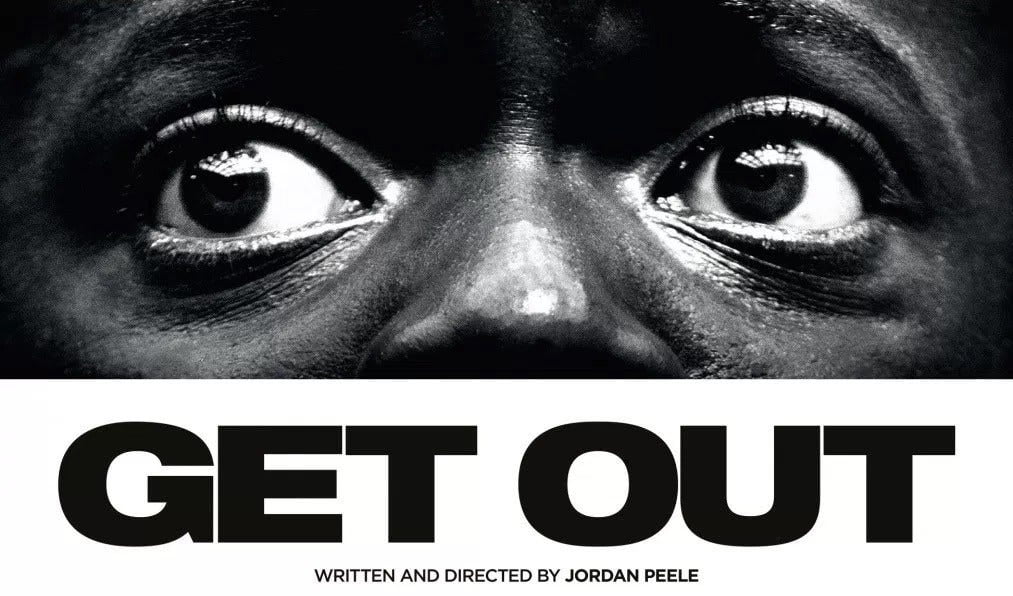
Get Out (2017)
Plot Summary
“Get Out” is Peele’s directorial debut and a groundbreaking entry in modern horror cinema. The film follows Chris Washington (Daniel Kaluuya), a young African American man, who visits the family estate of his white girlfriend, Rose Armitage (Allison Williams). What begins as an uneasy meeting with Rose’s parents, Dean (Bradley Whitford) and Missy (Catherine Keener), quickly descends into a nightmare as Chris uncovers the terrifying secrets lurking beneath the estate’s genteel exterior.
Detailed Scene Analysis
The Opening Scene
The film opens with a chilling sequence in which a Black man, Andre (Lakeith Stanfield), is abducted while walking in a suburban neighborhood. This scene sets the tone for the film, establishing a sense of unease and foreshadowing the racial tensions that underpin the narrative. The use of a white car and eerie music creates an atmosphere of dread, immediately signaling to the audience that this is a world where appearances can be deceiving and danger lurks beneath the surface.
The Family Estate
Upon arriving at the Armitage estate, Chris is greeted with seemingly warm hospitality. However, the interactions are laced with microaggressions and subtle cues that something is amiss. Dean’s awkward attempts to connect with Chris by referencing his admiration for President Obama and Missy’s insistence on hypnotizing Chris to cure his smoking habit are examples of how the film critiques performative allyship and the superficiality of liberal racism.


The Sunken Place
One of the most iconic scenes in “Get Out” is Chris’s descent into the “Sunken Place” during a hypnosis session with Missy. The Sunken Place serves as a powerful metaphor for the feeling of helplessness and marginalization experienced by Black individuals in a predominantly white society. Chris’s inability to move or speak while being fully conscious of his surroundings encapsulates the terror of being trapped in a state of powerlessness.
The Auction
The scene in which the Armitages hold a silent auction to sell Chris’s body is a harrowing depiction of the commodification of Black bodies. The film draws a parallel between this modern form of exploitation and the historical context of slavery, where Black people were treated as property to be bought and sold. The casual manner in which the Armitages’ friends bid on Chris further highlights the dehumanization inherent in this system.

The Escape
In the film’s climax, Chris fights for his life as he attempts to escape the Armitage estate. His resourcefulness and determination are on full display as he outwits and overpowers his captors. This sequence subverts the traditional horror trope of the helpless victim, instead portraying Chris as an empowered protagonist who takes control of his own fate.
Societal Issues
“Get Out” masterfully addresses several societal issues, including:
- Racial Appropriation and Fetishization: The Armitages’ obsession with Black physicality and their desire to inhabit Black bodies highlight the objectification and fetishization of Black people in white society. The film critiques the way in which Black culture and identity are often appropriated and commodified by those who do not understand or respect their significance.
- Microaggressions: The subtle, often unintentional, comments and actions by the Armitages and their friends underscore the everyday racism that Black people endure. These microaggressions, while seemingly benign, contribute to a broader system of racial inequality and oppression.
- Liberal Racism: The film critiques the veneer of liberalism that can mask deeply ingrained racist attitudes, exemplified by Dean’s claim that he would have voted for Obama a third time. This performative allyship fails to address the root causes of racism and perpetuates a superficial understanding of racial dynamics.

Character Tropes
Peele subverts traditional horror tropes by placing a Black protagonist at the center of the narrative. Chris is intelligent, resourceful, and perceptive, defying the often one-dimensional portrayal of Black characters in horror films. The film also inverts the “white savior” trope, with Chris saving himself rather than being rescued by a white character.
Chris Washington
Chris is a complex character whose experiences and emotions drive the narrative. His relationship with Rose is initially portrayed as loving and supportive, but as the story unfolds, it becomes clear that he is navigating a world fraught with racial tension and danger. Chris’s vulnerability and strength are both on display, making him a relatable and compelling protagonist.

Rose Armitage
Rose’s character is a masterful example of subverting expectations. Initially presented as the supportive and understanding girlfriend, she is later revealed to be complicit in her family’s sinister activities. This twist challenges the notion of the “good white ally” and forces the audience to reconsider their assumptions about Rose’s intentions and character.
The Armitages
The Armitage family embodies the insidious nature of liberal racism. Dean, Missy, and their children present themselves as progressive and accepting, but their actions reveal a deep-seated belief in white superiority and entitlement. Their polite exterior masks a horrifying reality, underscoring the film’s critique of performative allyship.

Us (2019)
Plot Summary
“Us” is Peele’s sophomore effort, a chilling tale of doppelgängers and societal reflection. The film follows Adelaide Wilson (Lupita Nyong’o) and her family as they confront their terrifying doubles, the Tethered, during a vacation at their beach house. The Tethered, who live in underground tunnels, emerge to exact revenge on their above-ground counterparts, revealing a dark and twisted connection between the two groups.

Detailed Scene Analysis
The Opening Scene
“Us” opens with a young Adelaide (Madison Curry) wandering away from her parents at a Santa Cruz beach carnival and encountering her doppelgänger in a hall of mirrors. This encounter sets the stage for the film’s exploration of duality and the uncanny. The scene’s use of mirrors and reflections symbolizes the theme of identity and the hidden aspects of the self.
The Home Invasion
The Wilson family’s home invasion by their doppelgängers is a tense and terrifying sequence. The Tethered’s eerie mimicry of the Wilsons’ movements and speech highlights the film’s exploration of the uncanny and the concept of the double. This scene also establishes the Tethered as a formidable and mysterious threat, raising questions about their origins and motivations.


Red’s Monologue
One of the film’s most memorable scenes is Red’s (Adelaide’s doppelgänger) monologue, in which she recounts the suffering of the Tethered. Her speech reveals the existence of a subterranean world where the Tethered are forced to mimic the actions of their above-ground counterparts without any of the benefits or joys. This revelation adds depth to the film’s critique of social inequality and the exploitation of marginalized groups.
The Ballet Fight
The climactic confrontation between Adelaide and Red is a beautifully choreographed ballet fight that intertwines violence and grace. The use of ballet as a motif throughout the film emphasizes the connection between the two characters and the idea of duality. The fight’s setting in an abandoned underground facility reinforces the film’s themes of repression and the consequences of ignoring societal issues.

Societal Issues
“Us” addresses several pressing societal issues, including:
- Class Disparity: The stark contrast between the lives of the Tethered and their above-ground counterparts highlights the deep economic and social divides in society. The film critiques the ways in which privilege and opportunity are distributed unequally, leading to the marginalization of certain groups.
- Identity and Otherness: The film explores how society defines and marginalizes the “other,” raising questions about identity, belonging, and the human cost of social stratification. The existence of the Tethered as mirror images of the above-ground characters suggests that the oppressed and the oppressor are intrinsically linked.
- Repression and Trauma: Adelaide’s suppressed memories and the emergence of the Tethered symbolize the return of repressed traumas and the consequences of ignoring societal issues. The film suggests that unresolved trauma and systemic neglect can lead to catastrophic consequences.
Character Tropes
In “Us,” Peele continues to challenge conventional character tropes. Adelaide is a complex, multifaceted protagonist whose struggle against the Tethered reflects broader societal conflicts. The film’s portrayal of the Wilson family, a middle-class Black family, defies stereotypical representations and highlights the universality of their experiences.


Adelaide Wilson / Red
Lupita Nyong’o’s dual performance as Adelaide and Red is a tour de force, showcasing her range as an actress. Adelaide’s character arc is defined by her struggle to protect her family and confront her past, while Red’s motivations are driven by a desire for revenge and justice. The revelation that Adelaide and Red switched places as children adds a layer of complexity to their relationship and forces the audience to question their perceptions of good and evil.

Gabe Wilson
Winston Duke’s portrayal of Gabe provides a counterbalance to the film’s tension with moments of humor and relatability. Gabe’s character subverts the trope of the macho protector, instead presenting a more nuanced and vulnerable portrayal of a father and husband trying to keep his family safe.
The Tethered
The Tethered are a haunting embodiment of the film’s themes of duality and social inequality. Their existence raises questions about the nature of identity and the ways in which society marginalizes and dehumanizes certain groups. The Tethered’s mimicry of their above-ground counterparts serves as a powerful visual metaphor for the ways in which the oppressed are forced to live in the shadows of the privileged.
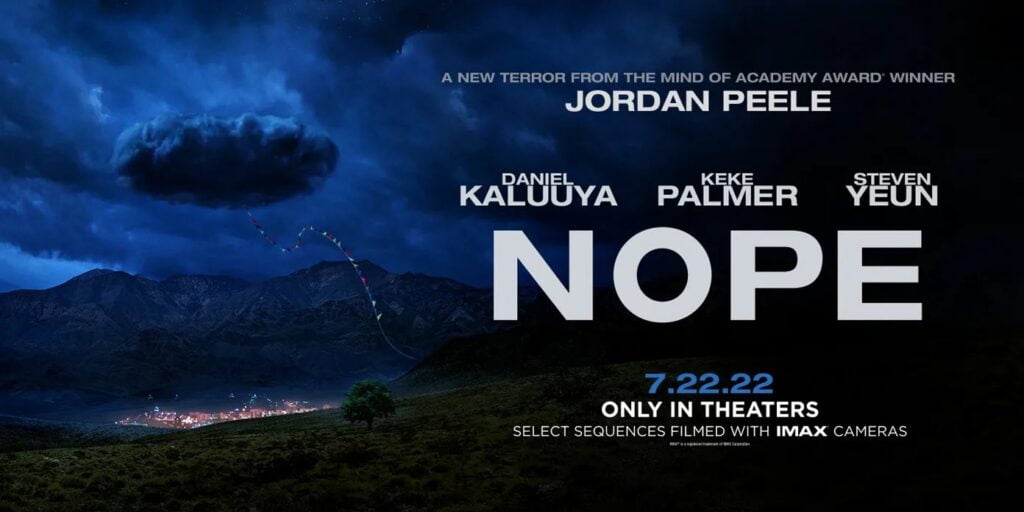
Nope (2022)
Plot Summary
“Nope” is Peele’s third feature film, a science fiction horror story that follows siblings OJ (Daniel Kaluuya) and Emerald Haywood (Keke Palmer) as they attempt to capture footage of a mysterious UFO that has been terrorizing their family’s horse ranch. The film explores themes of exploitation, spectacle, and the human desire to control and monetize the unknown.
Detailed Scene Analysis
The Opening Scene
The film opens with a disturbing image of a bloodied, lifeless chimpanzee on the set of a 1990s sitcom. This scene, later revealed to be from a traumatic incident involving a trained chimp named Gordy, sets the tone for the film’s exploration of the unpredictability of nature and the dangers of exploiting living beings for entertainment. The chilling image of Gordy covered in blood serves as a foreshadowing of the violence and chaos that will unfold.
The UFO Encounter
The first encounter with the UFO, dubbed “Jean Jacket” by OJ and Emerald, is a tense and suspenseful sequence. The UFO’s design and movement defy traditional depictions of extraterrestrial crafts, adding to the film’s sense of mystery and unease. The scene where the UFO abducts a horse emphasizes the unpredictability and danger of attempting to control the unknown.
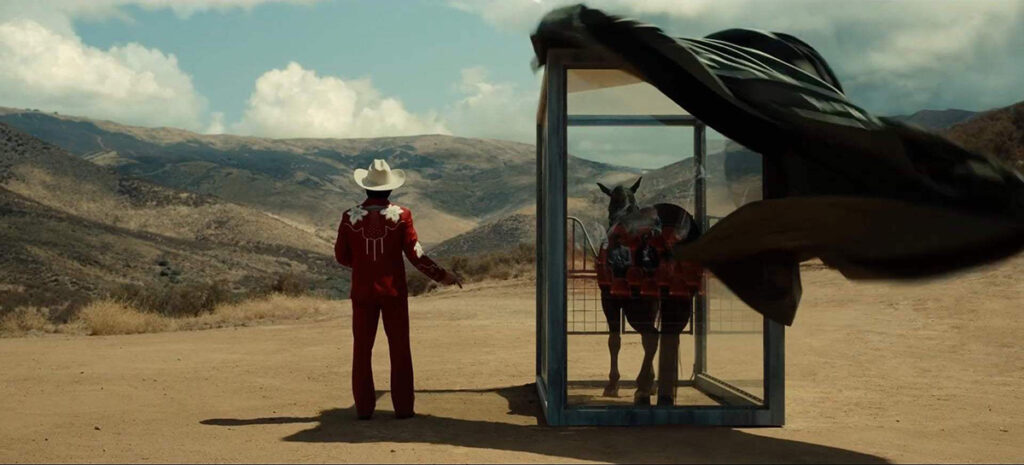

Emerald’s Monologue
Keke Palmer’s character, Emerald, delivers a powerful monologue about the Haywood family’s historical connection to early cinema. She recounts the story of their ancestor, a Black jockey featured in one of the first motion pictures, whose contributions were largely forgotten. This speech underscores the film’s themes of historical erasure and the struggle for recognition and agency within the entertainment industry.
The Finale
The film’s climax features a dramatic showdown between the Haywoods and the UFO. The siblings’ plan to capture footage of the UFO while protecting themselves and their ranch culminates in a thrilling and visually stunning sequence. The use of practical effects and minimal CGI adds a sense of realism to the spectacle, enhancing the film’s impact.
Societal Issues
“Nope” addresses several key societal issues, including:
- Exploitation and Spectacle: The film critiques society’s obsession with spectacle and the exploitation of individuals for entertainment purposes. The repeated attempts to capture and monetize footage of the UFO mirror the ways in which people and events are commodified for profit.
- Historical Erasure: By highlighting the Haywoods’ ancestral connection to early cinema, Peele underscores the erasure of Black contributions to the industry and the need for acknowledgment and representation. The film serves as a reminder of the often overlooked or forgotten achievements of marginalized groups.
- Surveillance and Control: The film explores themes of surveillance and control, as the characters’ attempts to capture the UFO reflect broader societal concerns about privacy and the commodification of the unknown. The relentless pursuit of the UFO’s footage parallels contemporary issues related to surveillance technology and the loss of privacy.

Character Tropes
Peele continues to subvert traditional character tropes in “Nope.” OJ and Emerald are resourceful, determined protagonists who challenge the typical portrayals of Black characters in science fiction and horror. Their dynamic as siblings adds depth to the narrative, emphasizing themes of family, legacy, and resilience.
OJ Haywood
Daniel Kaluuya’s portrayal of OJ is marked by a quiet strength and determination. OJ’s deep connection to his family’s ranch and his expertise with horses provide a unique perspective on the film’s events. His character subverts the trope of the impulsive hero, instead presenting a measured and thoughtful approach to the challenges he faces.
Emerald Haywood
Keke Palmer’s Emerald is a charismatic and ambitious character whose energy contrasts with OJ’s reserved demeanor. Her determination to honor her family’s legacy and secure their future drives much of the film’s action. Emerald’s resourcefulness and courage make her a compelling and relatable protagonist.
Angel Torres
Brandon Perea’s character, Angel, provides a tech-savvy ally to the Haywoods. His expertise with surveillance equipment and his enthusiasm for the UFO investigation add an additional layer of depth to the film. Angel’s character challenges the stereotype of the nerdy sidekick by presenting a multifaceted and integral member of the team.

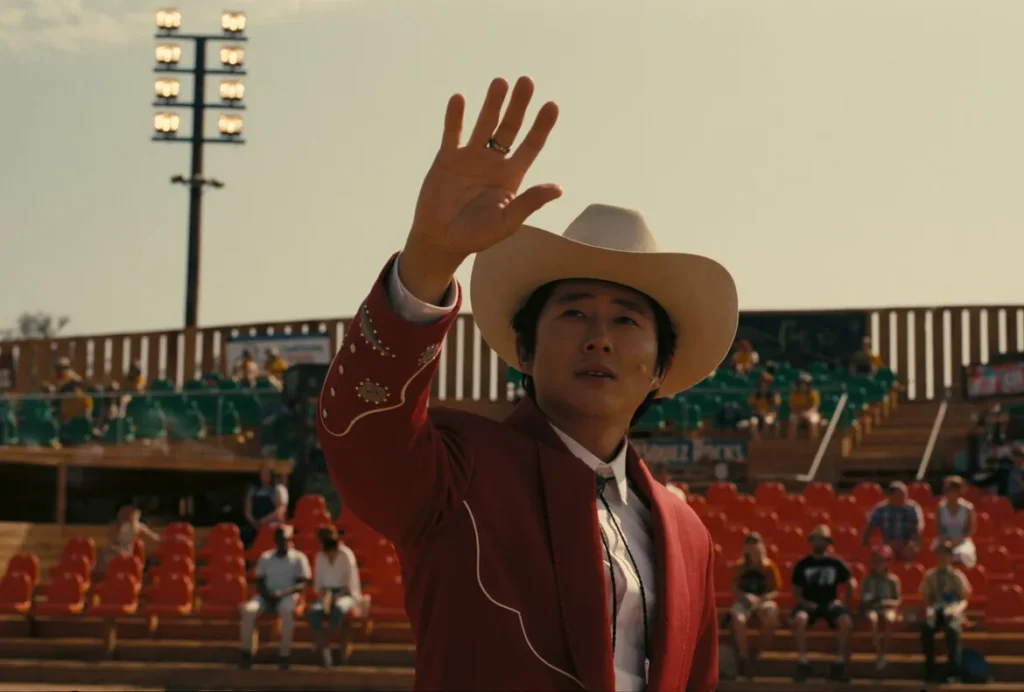
Societal Issues in Peele’s Cinema
Jordan Peele’s films are united by their incisive commentary on societal issues, often using the horror genre as a lens through which to explore complex themes. His work addresses:
- Racism and Racial Identity: Peele’s films frequently explore the dynamics of race and identity, exposing the subtle and overt forms of racism that permeate society. By centering Black protagonists and their experiences, Peele challenges traditional narratives and highlights the systemic inequalities faced by marginalized communities.
- Social Inequality: Whether through the depiction of class disparity in “Us” or the historical erasure highlighted in “Nope,” Peele consistently examines issues of social and economic inequality. His films underscore the ways in which privilege and opportunity are unequally distributed, often at the expense of marginalized groups.
- Exploitation and Commodification: From the objectification of Black bodies in “Get Out” to the exploitation of spectacle in “Nope,” Peele critiques the ways in which individuals and phenomena are commodified for profit. His films raise important questions about the ethics of entertainment and the human cost of commodification.
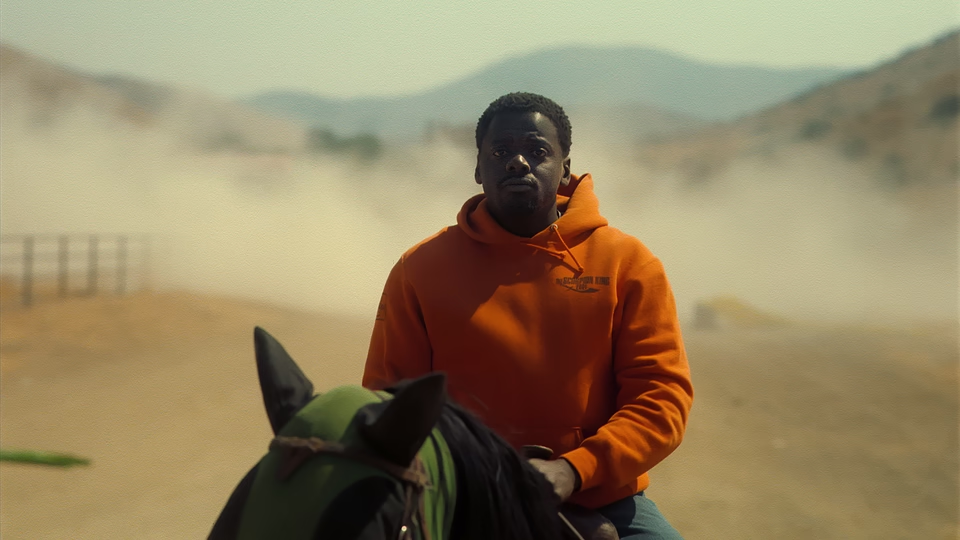
Character Tropes and Representation
Peele’s films are notable for their complex, well-developed characters, who often defy conventional tropes and stereotypes. His protagonists are typically:
- Resourceful and Intelligent: Characters like Chris in “Get Out” and the Wilson family in “Us” are portrayed as intelligent and resourceful, challenging the often one-dimensional depictions of Black characters in genre films. Peele’s characters are equipped with the skills and knowledge needed to navigate and survive their harrowing experiences.
- Multifaceted and Relatable: Peele’s characters are multifaceted, with relatable motivations and vulnerabilities. This depth adds emotional resonance to the films and encourages viewers to engage with the narratives on a deeper level. The characters’ struggles and triumphs reflect broader societal issues, making their stories universally relevant.
- Agents of Their Own Destiny: Peele’s protagonists are often depicted as agents of their own destiny, taking active roles in their narratives rather than being passive victims. This empowerment is a significant departure from traditional horror tropes, which often portray characters, especially marginalized ones, as helpless or expendable.

The Impact of Peele’s Cinema
Jordan Peele’s work has had a profound impact on contemporary cinema and the horror genre in particular. His films have sparked important conversations about race, identity, and social inequality, while also pushing the boundaries of genre filmmaking. Peele’s ability to blend horror with social commentary has inspired a new wave of filmmakers to explore similar themes in their work.
Redefining Horror
Peele’s films have redefined the horror genre by incorporating elements of social critique and psychological depth. “Get Out” and “Us” demonstrate that horror can be a powerful vehicle for exploring societal issues, challenging traditional notions of what the genre can achieve. Peele’s approach has opened the door for more diverse and complex narratives within horror, encouraging filmmakers to use the genre to address real-world concerns.
Elevating Representation
Peele’s commitment to centering Black protagonists and telling stories from a Black perspective has elevated representation in cinema. His films provide nuanced and authentic portrayals of Black characters, challenging stereotypes and offering new perspectives on their experiences. This focus on representation has resonated with audiences and critics alike, highlighting the importance of diversity in storytelling.
Influencing Filmmakers
Peele’s success has inspired a new generation of filmmakers to explore themes of race, identity, and social justice in their work. His films have demonstrated that there is a significant audience for socially conscious horror, paving the way for more diverse voices and stories in the genre. Peele’s influence can be seen in the increasing number of films that tackle complex societal issues through the lens of horror and genre filmmaking.



Jordan Peele has established himself as a visionary filmmaker, using his unique blend of horror, satire, and social critique to create films that are both entertaining and intellectually stimulating. His exploration of societal issues, coupled with his subversion of traditional character tropes, has redefined the horror genre and sparked important conversations about race, identity, and inequality. As Peele continues to push the boundaries of cinema, his work will undoubtedly remain a touchstone for both filmmakers and audiences seeking to understand and engage with the complexities of the modern world.
In the next sections, we will delve deeper into specific elements of Peele’s films, including detailed scene analyses, character studies, and further exploration of the societal issues he addresses. We will also examine the impact of Peele’s work on the horror genre and its influence on contemporary cinema. Stay tuned for an in-depth journey through the cinematic universe of Jordan Peele.
Further Exploration of Peele’s Films
The Use of Symbolism in “Get Out”
“Get Out” is rich with symbolism that enhances its commentary on race and identity. One of the most prominent symbols is the Sunken Place, which represents the systemic oppression and marginalization of Black people. Chris’s inability to move or speak while in the Sunken Place illustrates the powerlessness that many Black individuals feel in the face of racism.
The motif of eyes and vision is also significant. The Armitages’ desire to transplant the consciousness of white individuals into Black bodies highlights the idea of racial fetishization and appropriation. The camera flash that ultimately saves Chris serves as a metaphor for awareness and exposure, shedding light on the hidden truths of the Armitage family and their exploitation of Black bodies.
The Role of Family in “Us”
Family dynamics play a crucial role in “Us,” with the Wilson family’s bond serving as both a source of strength and vulnerability. Adelaide’s determination to protect her family drives much of the film’s action, while the Tethered’s desire to reclaim their rightful places highlights the theme of identity and belonging.
The duality between the Wilsons and their Tethered counterparts underscores the film’s exploration of privilege and inequality. The Tethered’s existence as shadow versions of the Wilsons raises questions about the societal structures that create and perpetuate disparities. The film suggests that the fates of the privileged and the marginalized are intertwined, with the actions of one group directly impacting the other.
The Concept of Spectacle in “Nope”
“Nope” delves into the concept of spectacle and the human desire to control and monetize the unknown. The characters’ attempts to capture footage of the UFO reflect broader societal obsessions with surveillance, control, and the commodification of phenomena for entertainment.
The film critiques the ethics of exploiting individuals and events for profit, drawing parallels between the UFO and the historical exploitation of marginalized groups. By highlighting the Haywood family’s struggle for recognition and agency within the entertainment industry, Peele underscores the ongoing issues of historical erasure and the commodification of Black contributions to cinema.

Character Studies
Chris Washington in “Get Out”
Chris is a nuanced and relatable protagonist whose journey reflects broader societal issues. His initial optimism and desire to connect with Rose’s family are gradually eroded as he uncovers the sinister reality of the Armitage estate. Chris’s resourcefulness and determination to survive highlight his strength and resilience, challenging traditional horror tropes.
His relationship with Rose is central to the film’s narrative, with their interactions serving as a lens through which to explore themes of trust, betrayal, and the complexities of interracial relationships. Chris’s ultimate triumph over the Armitages is a powerful statement about reclaiming agency and resisting exploitation.
Adelaide Wilson and Red in “Us”
Lupita Nyong’o’s dual performance as Adelaide and Red is a cornerstone of “Us,” with each character embodying different aspects of the film’s themes. Adelaide’s journey from victim to protector reflects her resilience and determination, while Red’s quest for justice and revenge highlights the consequences of systemic neglect and exploitation.
The revelation that Adelaide and Red switched places as children adds depth to their characters, challenging the audience’s perceptions of good and evil. This twist forces viewers to reconsider their assumptions about identity and the nature of the self, underscoring the film’s exploration of duality and otherness.
OJ and Emerald Haywood in “Nope”
The sibling dynamic between OJ and Emerald is central to “Nope,” with their contrasting personalities and shared goals driving much of the film’s action. OJ’s quiet determination and deep connection to the family ranch provide a grounding influence, while Emerald’s charisma and ambition add energy and urgency to their quest.
Their struggle to capture footage of the UFO and protect their family’s legacy reflects broader themes of historical erasure and the commodification of spectacle. The Haywoods’ resilience and resourcefulness challenge traditional portrayals of Black characters in science fiction and horror, offering a fresh perspective on the genre.

Societal Impact and Influence
Redefining Genre Boundaries
Peele’s work has redefined genre boundaries, blending horror with social commentary to create films that resonate on multiple levels. His ability to infuse genre filmmaking with intellectual depth and cultural relevance has expanded the possibilities of what horror can achieve, inspiring filmmakers to explore similar themes in their work.
Promoting Diversity and Representation
Peele’s commitment to diversity and representation has had a significant impact on the film industry. By centering Black protagonists and telling stories from a Black perspective, he has challenged traditional narratives and highlighted the importance of inclusive storytelling. Peele’s success has demonstrated that there is a substantial audience for films that reflect diverse experiences and perspectives.
Sparking Conversations About Social Issues
Peele’s films have sparked important conversations about race, identity, and social inequality, encouraging audiences to engage with these issues in new ways. By using the horror genre as a lens through which to explore societal concerns, Peele has created a powerful platform for discussing and addressing systemic injustices.
Final Words
Jordan Peele’s cinema is a testament to the power of storytelling to illuminate complex societal issues and challenge conventional narratives. Through his masterful blend of horror, satire, and social critique, Peele has redefined the genre and created a body of work that resonates with audiences and critics alike. His films offer nuanced portrayals of Black characters, subvert traditional tropes, and provide incisive commentary on race, identity, and social inequality.
As Peele continues to push the boundaries of cinema, his work will undoubtedly remain influential, inspiring future generations of filmmakers to explore the intersections of genre and social commentary. Jordan Peele’s films are not just works of entertainment; they are cultural artifacts that reflect and shape our understanding of the world, challenging us to confront our assumptions and strive for a more just and equitable society.









